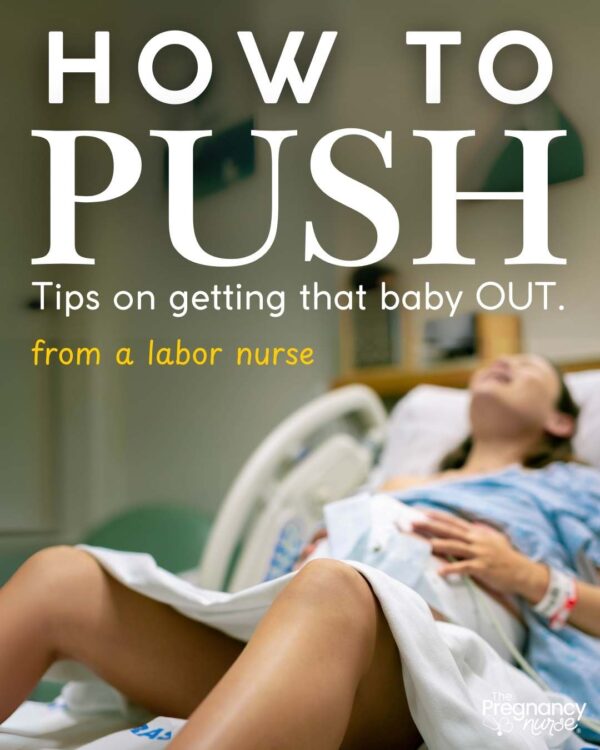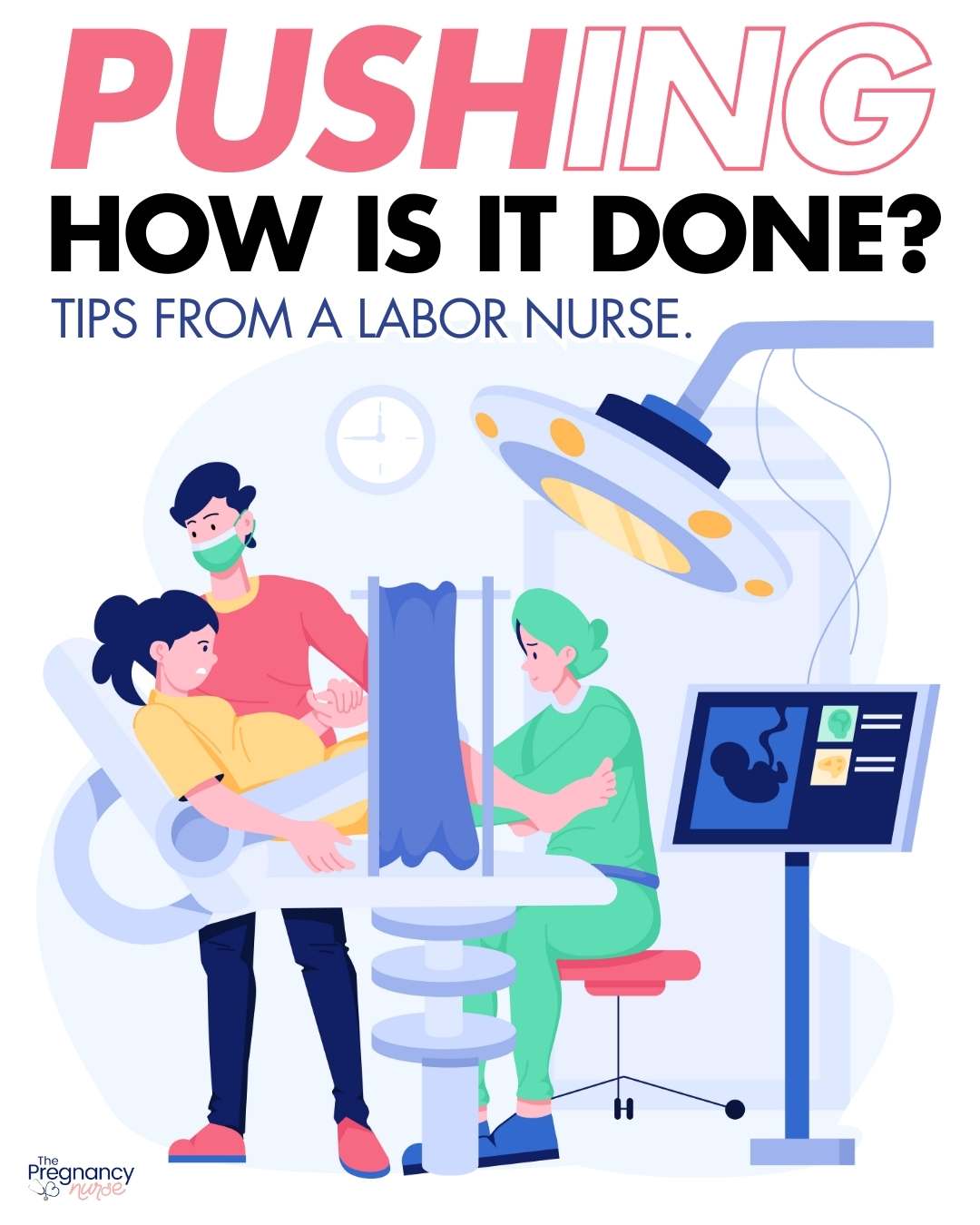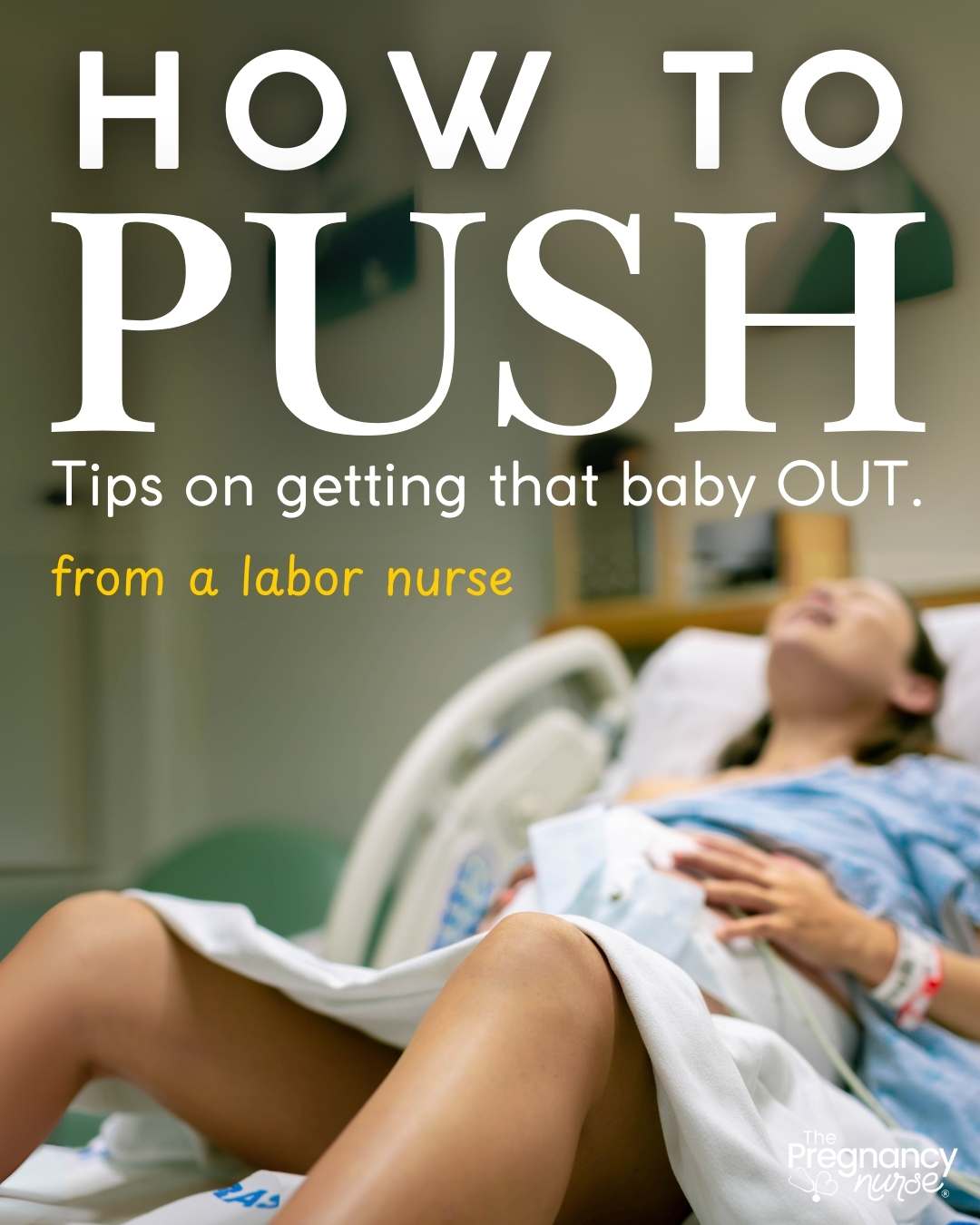📣 YOU are clearly getting prepared for pregnancy, birth & beyond — but do you wish your partner was more involved (looking for a teammate rather than just a cheerleader)? Couples love THIS! 💛🧡💚
You know that labor involves contractions, but how exactly does that baby get from the inside of your body outside of you? This post is going to help you know what happens once you’re fully dilated — how to push your baby out, how your body manages it (along with some helpful studies)…. I hope it’s very helpful for you to know what to expect!

Before we get started, talking this out on a video is much more helpful — and I talk about all your options in here. Understanding your options at this big moment is a big deal and that helps do just that!
Looking to get prepare for your birth? I have some easy options for you!
~~~~~~~~
– Worried you’re missing something? Grab my pregnancy planner so you don’t miss a thing!
– Thinking about an induction? Grab Inductions Made Easy to feel prepared in just 20 minutes!
– Wondering how to get that baby OUT? Grab Going Into Labor Made Easy so you know how to (and not to) do it!
– Postpartum got you anxious? Check out Postpartum Care Made Easy so you can stay SAFE even when all your attention is on that little on.
🚨 AND if ALL OF IT has got you on edge The Online Prenatal Class for Couples is perfect for you — You’ll feel so ready before you even know it!
~~~~~~~~
No matter WHERE you are at in your pregnancy journey, we have resources that can help!
What is pushing?
So, once your cervix is gone, your body most often needs some pushing to get the baby out.
Honestly, the process is very similar to pooping…
You’re just going to bear down, just like you do for that process.
Sometimes an epidural makes it hard to coordinate the muscles to push and I just tell patients to envision themselves constipated on the toilet and do their thing, within a few rounds they’re most often doing great.
(If not, you can ask for the epidural to be turned down a bit to make it easier)
What Do The Studies Show on Pushing?
There are a good number of pushing studies out there. I wasn’t able to find all the ones I’ve heard about, but I will tell you what providers most often cite as to how we recommend you push (but don’t worry I agree that just because a study says xyz doesn’t mean it’s right for you).
Delayed vs Initiated Pushing
This means do you push right away once your cervix has disappeared (has fully dilated) or after baby has descended a bit.
Delayed pushing does seem to be associated with less pushing time.
However delayed pushing has also been associated with increased risks of uterine infection and hemorrhaging.
Don’t worry, we will talk more about this…. Keep reading!
Directed vs Spontaneous Pushing
This means are we telling you to push to 10 or are you just pushing on your own?
Studies don’t really seem to show too much of a difference between these two.
I saw some pretty conflicting evidence about what it could/couldn’t do for your pelvic floor. Honestly, there doesn’t seem to be a right answer in these areas for everyone and really needs to be taken on a case-by-case basis. Be sure to see my post on perineal massage for more on that.
Again, we’ll talk about what’s best for you…
Open glottal vs Closed Glottal Pushing
Open glottal pushing allows you to moan and let some air out as you push.
Closed glottal is where you close your lung capacity and push without letting air out.
Again, studies seem really mixed on this one — no clear “winner”…
Sources for this info:
- Lemos A, Amorim MM, Dornelas de Andrade A, de Souza AI, Cabral Filho JE, Correia JB. Pushing/bearing down methods for the second stage of labour. Cochrane Database Syst Rev. 2017 Mar 26;3(3):CD009124. doi: 10.1002/14651858.CD009124.pub3. PMID: 28349526; PMCID: PMC6464699.
- Optimizing the length of the second stage and management of pushing; Cahill, Alison G. et al.American Journal of Obstetrics & Gynecology, Volume 230, Issue 3, S876 – S878
- Jiasi Yao, Heike Roth, Debra Anderson, Hong Lu, Xianying Li, Kathleen Baird,
- Benefits and risks of spontaneous pushing versus directed pushing during the second stage of labour among women without epidural analgesia: A systematic review and meta-analysis,
BTW, you’re likely in or near your 3rd trimester, grab my checklist here:
How Should YOU Push?
This is ultimately what it comes down to — there really is not CLEAR way to push (like a study that clearly showed an issue however you’re pushing).
What I always recommend is to “try-on” several options.
Here’s a few to consider:
When to push?
There are a few things to ask if you should start pushing now, or wait?
How high in the birth canal is the baby? If baby is high you often have to push longer, so letting your body do the work before you engage in pushing can help. However, different positions and rotations should be employed while you wait (don’t just sleep in one spot)
How tired are you? If you just got an epidural and you’re SO tired, you just need a nap before baby comes, take one! Keep in mind that sometimes when you relax with a nap you may wake-up to a lot of pressure “down there” and baby has descended quickly and is ready to come out (this is not always the case though, so don’t expect it).
How long has this been going on? Have you had a lot of Pitocin with a long induction and been in labor for a while? Your chances of infection and blood loss are greater because of that, so waiting to push may not be worth it.
How long to wait? Just because you’re waiting doesn’t meant you have to wait until you see the baby’s eyeballs…. Most articles seemed to feel like waiting an hour wasn’t bad, but waiting longer than that might not ultimately be worth it.
As a note, just because you wait doesn’t mean you still may be pushing for an hour+ (even the 2 hours). It’s just letting your body do some of the heavy lifting before you take over.
Just because they say “time to push” doesn’t mean you have to push. You can always ask and review those questions above. If you’d like to wait — feel free to wait. Most often waiting (and moving your pelvis) does require less pushing on your part, but can have risks.
Like all things in labor, it’s up to you — but sometimes people have no idea what they want, so thinking about all of this ahead of time is smart.
There’s lots of choices to make in labor — get my best tips to making your birth plan here:
Push to 10?
In the movies you may have seen people pushing to 10. The reason we do this as nurses is that longer pushes are more effective. It’s very much a two steps forward, one step back phenomenon, so the longer you push the further you get before relaxing, and baby pushing back up into the birth canal.
However a lot of people feel like they’re back in PE class with that, and really hate it.
With patients I’d start out with them pushing on their own, and then I’d ask if they’d like to try to 10 and we can see what works better.
Sometimes when people have an idea of the long pushes they don’t need us counting to ten, and they can push plenty long on their own.
Again, figure out what works best for you — but if pushing is taking a while I recommend trying a few different ways.

Open or Closed-Glottal Pushing?
Again, try different ways. Try some pushes with your glottis closed, and try it with it open. Ask your nurse if she’s seeing a difference.
One thing you need to know is that it is partly the air in your lungs, pushing against your diaphragm that helps baby make progress into the birth canal.
If you let all that air out moaning (or screaming) it usually does make pushing less effective.
So, try to keep some air in your lungs no matter how you’re doing it. But, try different things, see what you like best or what seems to work best.
Pro Tip: You can rotate between the two (or frankly all these choices) Nothing says you have to pick a “way” and keep doing that til’ baby is out!
What position to push in?
This one is super controversial online — I have a whole post on if you have to push on your back that is really popular. I’d recommend reading that post.
But, like everything I say try some different things.
If you’ve got an epidural, your pushing positions are a bit limited. Your legs won’t hold you up, and while online people seem to act like pushing on all 4’s can be done, most people find it really uncomfortable after a few pushes, so you can rotate between:
- Pushing partially on your side
- Pushing all the way on your side
- Using the pedals, handles and bed in different ways
- Using a birth ball or a peanut ball to help you push
If you don’t have an epidural you can push in whatever way feels best. Some positions can be difficult to monitor baby in (and if that’s important to you, you’ll want to accommodate how baby can be monitored).
Some hospitals/states may have rules about pushing in the bathtub or shower. It’s something to be aware of if you’re hoping for something along those lines. You can always do what you want, but you need to ask why the rules are there, and the make choices for yourself.
I always had patients try a variety of positions and then see what felt best. No reason not to.
I just read this study that talked about making sure you’re not in one position too long (be it squatting or legs pulled up towards your chin) to prevent nerve damage.
Want to know more labor tips — check out these posts:
- What a Birth Plan Can ACTUALLY Do For Your Birth?
- What do People Wish They Had Known About Before Birth?
- Advocating For Yourself in Labor
- 5 Things You CAN Control in Labor (mostly)
- 3 Things to Know About Perineal Massage
Why All this Talk of Pushing?
Some of you may be wondering why we’re talking about pushing so much?
The reality is that the average pushing time on your first baby is just under 2 hours. Which means you have a lot of time and a lot of pushes to try different things (and also waste effort if what you’re doing isn’t working).
So, it’s important to come prepared with some different ideas and plans for pushing.
Luckily, on subsequent babies, normally, pushing time isn’t too long at all. The average, overall, pushing time is about 20 minutes when you combine the two.
If you’ve previously had a vaginal delivery, this time shouldn’t be as long. However, it can be longer than you’d expect if baby is large or mal-positioned, etc.
What’s the Fetal Ejection Reflex?
I hear so often that the fetal ejection reflex will take over and baby will just come out on it’s own.
I wish I lived in this magical world, but I don’t see it all that often.
Yes, women have an “urge” to push without an epidural most often (sometimes they get it with the epidural too — see my post on walking epidurals for more info).
It’s similar to how you feel when you need to have a BM. Your body knows you need to do it and it may start pushing on it’s own if you’ve delayed it for a bit.
However, on most first babies that isn’t enough to “eject” the baby. That still requires a bit of time and effort.
So, it may happen to you, but likely will not — in my 20 years of experience.
In Summary
⭐ Pushing is often longer than people anticipate. It’s important to take a class to be well-informed on what to expect during labor so you’re not caught off-guard by stuff.
⭐ Feel free to make your voice heard. If you’d like to wait, change positions or how you push — just ask. The nurse feels the need to “drive the bus” when you’re not doing. But, once you make your voice heard we’ll want to know more about what you want.
⭐ Feel free to ask for ideas on how to make it different. Other positions, other ways to push or assistants to push (like a mirror, or peanut ball) can be really helpful! Mix it up!
⭐ And finally, a reminder that just because studies showed a small change with xyz doesn’t always mean it’s right for you. This birth is YOUR birth and we’ve never studied it before. Every one is different and we have to make choices based on what’s going on for you, not what happened in one particular study.
That doesn’t mean studies aren’t helpful, but they often can’t be applied exactly to every situation.
Learning to get the information from your team so that you can make choices for yourself is one of the most important parts of labor and managing healthcare in general.
The Online Prenatal Class for Couples was the birth class aimed to do just that. In just a few hours we can have you:
- Prepped for different pain management options including some natural pain management methods that can help!
- Knowing how to get information from trusted sources and make your own choices
- Proper expectations for your body & labor so you’re not traumatized by your own misinformation.
It really is so smart to get prepared for all of that, I want that for you. Use code FASTERBIRTH to get 10% off!
Want to do a vibe check before diving into the whole thing with me? — check out my free labor pro tips. It’s your first step toward getting in the driver’s seat of your birth.
And, if you’d like to learn more on this topic, I have a video for you too:











 Master Labor Preparation: How Online Classes Help Couples Thrive
Master Labor Preparation: How Online Classes Help Couples Thrive
